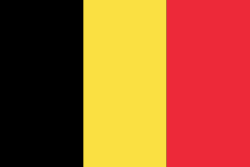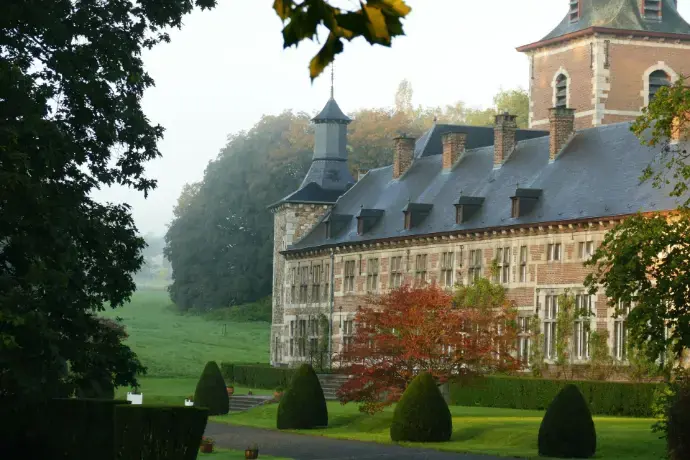PRIEURE DE BEAUFAYS
Nine centuries ago, a community of canons settled on a hill south of Liège, in a place known as “Belle-Fontaine”. They built a church, a keep, a priory, a farm, and a brewery.
Today, the main part of the estate still belongs to the Laloux family, who acquired it in 1890.
PRESENTATION
Founded in 1123, Beaufays Abbey has witnessed over nine centuries of history, first under the authority of the Bishop of Verdun, then under the Prince-Bishop of Liège. Following the French Revolution, the estate was sold in 1796. After passing through several owners and serving as a girls’ boarding school in 1875, the Liège industrialist Adolphe Laloux purchased Beaufays in 1890. He undertook major restoration works and designed stunning landscaped gardens.
Built in 1701, the current church is an architectural Baroque-style masterpiece. The estate also houses the recently restored Henri de Goha Pavilion, a jewel of Liège’s heritage, featuring a remarkable Louis XIV stucco ceiling adorned with oak and acanthus leaves.
Le domaine abrite également le pavillon Henri de Goha, un petit joyau du patrimoine architectural liégeois. Restauré en 2024, il est orné d’un plafond stuqué de style Louis XIV, aux motifs de feuilles d’acanthe et de chêne.
In collaboration with a local brewery, the abbey continues to make the “Prieuré de Beaufays”, an abbey beer inspired by centuries-old Augustinian brewing tradition.
WALEFFE CASTLE
Niché dans un cadre naturel d’exception, le château de Waleffe, érigé en 1706, est l’extension d’une ferme fortifiée datant du XVIè siècle. Classée au patrimoine exceptionnel de Wallonie, il appartient depuis 1580 à la famille des barons de Potesta de Waleffe, descendants directs du Grand Curtius, célèbre industriel et grand mécène de la ville de Liège.
PRESENTATION
Le château de Waleffe incarne l’élégance du style classique du XVIIIe siècle. Son intérieur somptueusement décoré mélange les influences Louis XIV et Louis XV, offrant un cadre raffiné avec meubles d’époque, tapisseries et œuvres d’art. Inspiré par l’architecte Daniel Marot, le château marie simplicité et sophistication. Ce lieu a joué un rôle stratégique durant la Seconde Guerre mondiale en servant de refuge pour des membres de l’Armée secrète.
Le parc, avec son allée de tilleuls et sa charmille bicentenaire, fut réaménagé au XIXe siècle. Des sculptures en terre cuite ornent la cour d’honneur, tandis qu’un jardin en broderie témoigne du raffinement paysager d’autrefois. Un espace dédié à l’herboristerie propose des ateliers sur les plantes médicinales et la phytothérapie.
LASSUS CASTLE
Lassus Castle, set in the picturesque village of Hamoir along the Ourthe River, is a historic residence full of character.
To breathe new life into the estate, the current owners, Sabine and Jean-François Rancelot, have transformed part of the castle into charming holiday rentals.
PRESENTATION
Built in three different periods, the 13th, 18th and 19th centuries, this castle is an interesting architectural ensemble. The building, surrounded by gardens and a landscaped park, is set in an exceptional green setting, the Ourthe valley immortalised by the great painter Richard Heinz, the “Master of Sy”.
REINHARDSTEIN CASTLE
Perched on a rocky outcrop in the heart of the High Fens, Reinhardstein Castle proudly overlooks the Warche River. It is the only Eifel style castle in Belgium and the highest in the country.
The castle is owned by the non-profit organisation Reinhardstein, which is dedicated to preserving, enhancing, and bringing this historic site to life.
PRESENTATION
In 1354, Wenceslas of Luxembourg granted Renaud de Waimes permission to build a castle on this site. Over the centuries, it changed hands between several noble families, including Zivelle, Schwarzenberg, Brandscheid, Spontin, and Nassau.
In 1550, following the marriage of Anne of Nassau and Wilhelm von Metternich, the castle became part of this influential Rhineland dynasty, which retained it until the French Revolution. Left abandoned for over 150 years, it fell into ruin until 1965, when historian Jean Overloop took on the challenge of restoring it. With the help of local craftsmen and a group of friends, he meticulously rebuilt the castle over eighteen months, establishing a non-profit organisation to support its revival.











